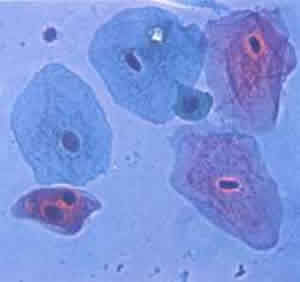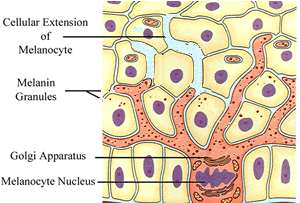Skin
The skin is composed of two
layers:
- an outer layer called the epidermis
- an inner layer called the dermis.
Click to see a larger view of the cross
section of the skin worksheet.
The epidermis is primarily responsible for protection of the body by providing a tough, flexible and water proof covering. The epidermis is made up of many layers of epithelial cells. These cells are specially designed to enable the epidermis in forming a complete cover.

Epithelial cells a flat and overlap each other, as seen on the right. At the bottom of the epidermis is a layer of cells which is constantly dividing. This layer is the source of new cells that are constantly needed to replace old and worn out cells as they flake off the surface of the skin. The new cells grow and are pushed upwards towards the surface. As they go further up they become flatter and wider and develop a build up of a protein called keratin. As they near the surface of the skin the epithelial cells die. These dead cells provide a tough, thick, waterproof, layer that completely covers the body.

This layer of dead cells varies in thickness in different parts of the body depending on the wear and tear on that particular part. The skin on the soles of our feet, for example, is thicker than the skin on our head. The relative thickness of each area is shown on the right, where "A" represents the thickness of skin on the soles of our feet and "B" the thickness of skin on our foreheads.
Dandruff is an example of the skin continually renewing itself.

